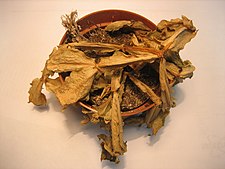Wilting point
The permanent wilting point (PWP) or wilting point characterizes the degree of desiccation of a soil. The term comes from plant ecology .
Dries a floor to the permanent wilting point of which is water so strongly bound in the well rooted soil horizon that plants irreversible ( irreversibly ) wilt.
With such a low soil moisture, the plant roots can not develop a comparably high suction tension in order to absorb the water from the soil. In the conduction pathways of the plant ( xylem ), the capillary flow of water breaks away from the roots to the leaves, and air enters. As a result, the plant wilts .
The permanent wilting point is to be understood as a convention. There are drought-resistant plants, mainly xerophytes , which can overcome significantly higher suction pressures. In addition, it is not only the hydrostatic pressure that is decisive for the withering of a plant, but also the water conductivity of a soil.
At the withering point PWP, all water-bearing coarse and medium pores, i.e. soil pores with an equivalent diameter of> 0.2 µm, have dried out. The permanent wilting point is at a soil pF value of 4.2. This corresponds to a suction stress of −1.5 MPa or 150 m water column in relation to the groundwater level.
The amount of water that a soil can keep plant-available between field capacity and permanent wilting point depends largely on the humus content and the grain size distribution in the soil. This relationship becomes visible in the water tension curve of a soil. The water content of the PWP gives a good comparison value for the clay content of a soil.
Under Central European climatic conditions, soils dry out only in a top layer from a few cm to the wilting point PWP.
See also
literature
- Karl Heinrich Hartge : Introduction to Soil Physics. Enke, Stuttgart 1978, ISBN 3-432-89681-6 .
